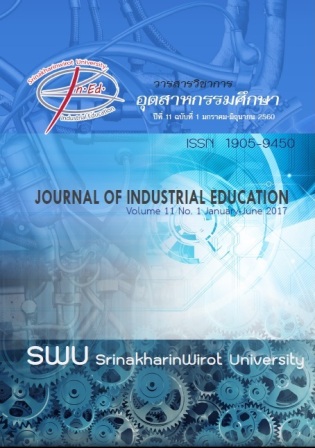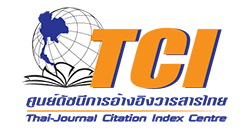รูปแบบการบริหารความเสี่ยงของสถานศึกษา
Abstract
บทคัดย่อ การวิจัยครั้งนี้ความมุ่งหมายของการวิจัย 1) เพื่อศึกษาการบริหารความเสี่ยงของสถานศึกษา 2) เพื่อสร้างรูปแบบการบริหารความเสี่ยงของสถานศึกษา และ 3) เพื่อประเมินรูปแบบการบริหารความเสี่ยงของสถานศึกษา การดำเนินการวิจัยประกอบด้วย 3 ขั้นตอน ได้แก่ ขั้นตอนที่ 1 การศึกษาสภาพปัจจุบัน กลุ่มตัวอย่าง ได้แก่ ครู และบุคลากรทางการศึกษาในโรงเรียนสีขาว สังกัดสำนักงานเขตพื้นที่การศึกษาประถมศึกษานครราชสีมา จังหวัดนครราชสีมา จำนวน 159 คน ซึ่งได้ขนาดกลุ่มตัวอย่างจากตารางกำหนดขนาดกลุ่มตัวอย่างของเครจซี และมอร์แกน โดยสุ่มแบบแบ่งชั้น การหาคุณภาพด้านความตรงตามเนื้อหา (Content Validity) ได้ค่าความสอดคล้องระหว่าง 0.80-1.00 การหาค่าสัมประสิทธิ์ แอลฟา (Alpha-Coefficient) ของครอนบาคได้ค่าความเชื่อมั่นเท่ากับ 0.93 ขั้นตอนที่ 2 ขั้นสร้างรูปแบบ การเลือกเป้าหมาย ใช้วิธีสนทนากลุ่ม ได้แก่ ผู้เชี่ยวชาญด้านการบริหารจัดการศึกษา ซึ่งเป็นบุคคลที่มีความรู้ ความสามารถ จำนวน 10 คน ขั้นตอนที่ 3 ขั้นประเมินรูปแบบใช้การสำรวจโดยใช้แบบสอบถาม การเลือกเป้าหมาย ได้แก่ ผู้บริหารโรงเรียนที่บริหารโรงเรียนสีขาวที่เป็นกลุ่มเสี่ยง และเป็นผู้บริหารมาแล้วไม่น้อยกว่า 2 ปี โดยใช้การเลือกแบบเจาะจง จำนวน 10 คน สถิติที่ใช้ในการวิเคราะห์ข้อมูล ได้แก่ ค่าร้อยละ (Percentage) ค่าเฉลี่ย (Mean) และส่วนเบี่ยงเบนมาตรฐาน (Standard Deviation) และข้อมูลเชิงคุณภาพใช้การวิเคราะห์เชิงเนื้อหา ผลการวิจัยพบว่า 1. สภาพการบริหารความเสี่ยงของสถานศึกษา โดยภาพรวมอยู่ในระดับมาก 2.รูปแบบการบริหารความเสี่ยงของสถานศึกษา ประกอบด้วยองค์ประกอบ 4 องค์ประกอบ 1) การส่งเสริมการมีส่วนร่วมในการกำหนดวัตถุประสงค์ และเป้าหมายการดำเนินงานขององค์กร 2) การติดตามโครงการอย่างใกล้ชิดเพื่อตรวจวัดการบรรลุผลสำเร็จตามวัตถุประสงค์ 3) ความรัดกุมในการวางแผน การจัดทำ การควบคุม และการติดตามประเมินผลการใช้จ่ายงบประมาณ และ 4) ผู้บริหารพึงปฏิบัติตนเป็นตัวอย่างที่ดีแก่ผู้ใต้บังคับบัญชา 3. การประเมินรูปแบบการบริหารความเสี่ยงของสถานศึกษา มีความเหมาะสม และความเป็นไปได้ในการนำไปสู่การปฏิบัติอยู่ในระดับมาก คำสำคัญ: รูปแบบการบริหารความเสี่ยง Abstract This objectives of this study were; 1) Study risk management of basic schools. 2) Develop a model of risk management of basic schools, and 3) Evaluate the developed model. This research consists of three stages: stage 1: study current condition of the schools, the samples were 159 teachers and educational personnel of basic schools under the Office of Nakhonratchasima Primary Educational Service Area which derived from the Krejcie & Morgan’s sampling table with IOC between 0.80-1.00 and Alpha-Coefficient of 0.93.stage 2: develop a risk management model with focus group technique. The focus group technique was applied with 10 experts. And Stage 3: evaluate the developed model using survey technique with 10 school administrators in “the white school project” who have been in the management position at least 2 years with purposive sampling. The statistics used for data analysis were percentage, mean, standard deviation and content analysis. The findings were found that: 1. The overall current condition of risk management of the schools is at the high level. 2. A model of risk management of the schools comprise of 4 components: 1) promotion for participation in setting objective and goal of an organization, 2) continue and thoroughly monitoring the project to evaluate and check for goal achievement, 3) effectiveness and precisely in budget planning, execution and control, and 4) an administrators shall be a role model to their subordinates as well. 3. The appropriateness of risk management model is at a “high” level. Keywords: Risk management modelDownloads
Download data is not yet available.
Downloads
Issue
Section
บทความวิจัย




